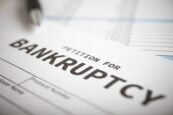
Will I Go Bankrupt If I Am A Director Of A Company That Goes Bust?
Will I Go Bankrupt If I Am A Director Of A Company That Goes Bust?
If a company is unable to pay its debts and is no longer viable then a Creditors Voluntary Liquidation (CVL) tends to be the best option. The directors start the process by appointing a licensed insolvency practitioner to put together a statement of affairs of the company and contact all the creditors. In a CVL, there are two key meetings. Firstly, a meeting with the company members and shareholders, secondly, a meeting with the company’s creditors.
With the shareholders and company members, the liquidators will discuss and decide upon a resolution to try and put the company into liquidation.
Up to 14 days after the shareholders meeting (note: it can be arranged for the same day), a creditors meeting is arranged. A 7 days notice period must be given, to allow the maximum number of creditors to attend. With the notice, two other forms, a form of proxy and the proof of debt form, are given to creditors, which must be read, signed and brought back to the meeting.
In a creditors meeting, the insolvency practitioner will explain the companies financial position and outline the statement of affairs. Additionally, the reason for the liquidation is shared. Within these meetings, creditors are allowed to ask questions regarding the information they’re being told. Funnily enough the most usual question is “where has all the money gone?” . At the meeting the creditors are asked to approve the insolvency practitioner as the liquidator. In some cases the creditors may not want the insolvency practitioner appointed as they wish to have more control of the process. As such, they will bring their own insolvency practitioner to the meeting who will seek to get appointed. Large companies that supply lots of businesses often go down this route, as do lenders. This is why the process is called “creditors” voluntary liquidation.
A hardcopy of the statement of affairs is given to all creditors. Within 28 days of the meeting, creditors must receive a summary of the meeting and all agreements.
The Insolvency Act 1986 outlines the legal procedures for all matters for everything relating to both personal and corporate UK Insolvency. Section 98 relates to the procedures for the creditors meetings.
The procedure for the meetings of creditors can be found here https://www.legislation.gov.uk/ukpga/1986/45/section/98 .
In 2016, a set of new rules was integrated into the 1986 version, to modernize the law. This document can be found here https://www.legislation.gov.uk/uksi/2016/1024/pdfs/uksi_20161024_en.pdf .
Firstly, the requirement for physical section 98 meetings, is abolished. Instead, virtual meetings or processes of deemed creditor consent are held. With processes of deemed creditor consent, the directors send written proposals to creditors regarding nominating a liquidator. If 10% or more object to these proposals, then the directors must call a physical meeting with creditors, to make a decision, if not, the proposal is approved.
There are alternatives to deemed creditor consent. These are ;
Another new rule is that final meetings have been abolished. This means that creditors now have a right to object to the proposal, within a period of 8 weeks from the delivery of the prescribed notice, or determination of applications for further information or challenges to remuneration.
Other 2016 rule changes involve:

Will I Go Bankrupt If I Am A Director Of A Company That Goes Bust?
Will I Go Bankrupt If I Am A Director Of A Company That Goes Bust?
Guide To Liquidation Fees
Guide To Liquidation FeesBusiness Asset Disposal Relief
Business Asset Disposal Relief
How Long Does It Take To Liquidate A Company?
How Long Does It Take To Liquidate A Company?
Trading Whilst Insolvent – Worried Directors Guide
Trading Whilst Insolvent – Worried Directors Guide